2006 DODGE RAM SRT-10 engine
[x] Cancel search: enginePage 2487 of 5267
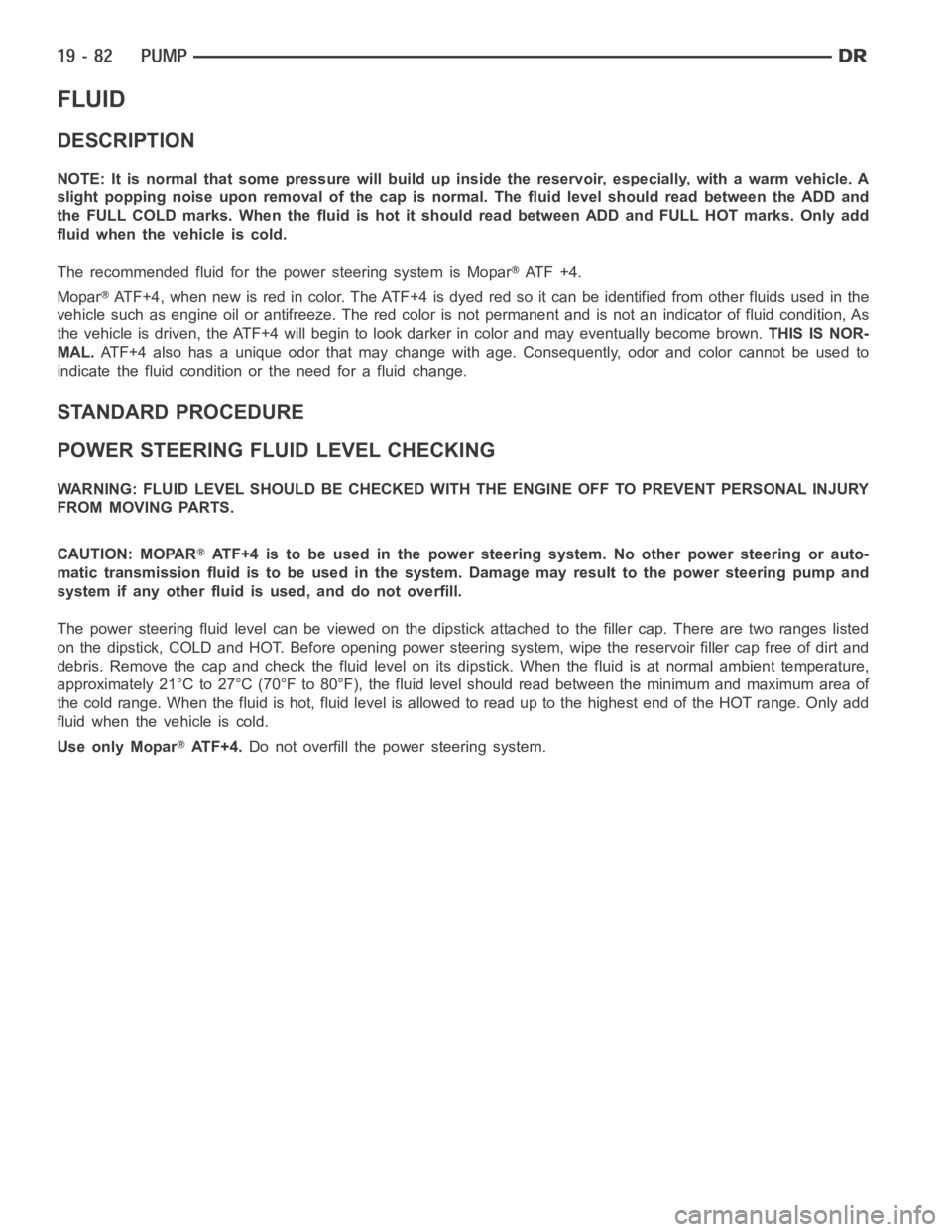
FLUID
DESCRIPTION
NOTE: It is normal that some pressure will build up inside the reservoir, especially, with a warm vehicle. A
slight popping noise upon removal ofthe cap is normal. The fluid level should read between the ADD and
the FULL COLD marks. When the fluid is hotit should read between ADD and FULLHOT marks. Only add
fluid when the vehicle is cold.
The recommended fluid for the power steering system is Mopar
AT F + 4 .
Mopar
ATF+4, when new is red in color. The ATF+4 is dyed red so it can be identified from other fluids used in the
vehicle such as engine oil or antifreeze. The red color is not permanent andis not an indicator of fluid condition, As
the vehicle is driven, the ATF+4 will begin to look darker in color and may eventually become brown.THIS IS NOR-
MAL.ATF+4 also has a unique odor that may change with age. Consequently, odor and color cannot be used to
indicate the fluid condition or the need for a fluid change.
STANDARD PROCEDURE
POWER STEERING FLUID LEVEL CHECKING
WARNING: FLUID LEVEL SHOULD BE CHECKED WITH THE ENGINE OFF TO PREVENT PERSONAL INJURY
FROM MOVING PARTS.
CAUTION: MOPAR
ATF+4 is to be used in the power steering system. No other power steering or auto-
matic transmission fluid is to be used in the system. Damage may result to the power steering pump and
system if any other fluid is used, and do not overfill.
The power steering fluid level can be viewed on the dipstick attached to thefiller cap. There are two ranges listed
on the dipstick, COLD and HOT. Before opening power steering system, wipe the reservoir filler cap free of dirt and
debris. Remove the cap and check the fluid level on its dipstick. When the fluid is at normal ambient temperature,
approximately 21°C to 27°C (70°F to 80°F), the fluid level should read between the minimum and maximum area of
the cold range. When the fluid is hot, fluid level is allowed to read up to thehighest end of the HOT range. Only add
fluid when the vehicle is cold.
Use only Mopar
AT F + 4 .Do not overfill the power steering system.
Page 2488 of 5267
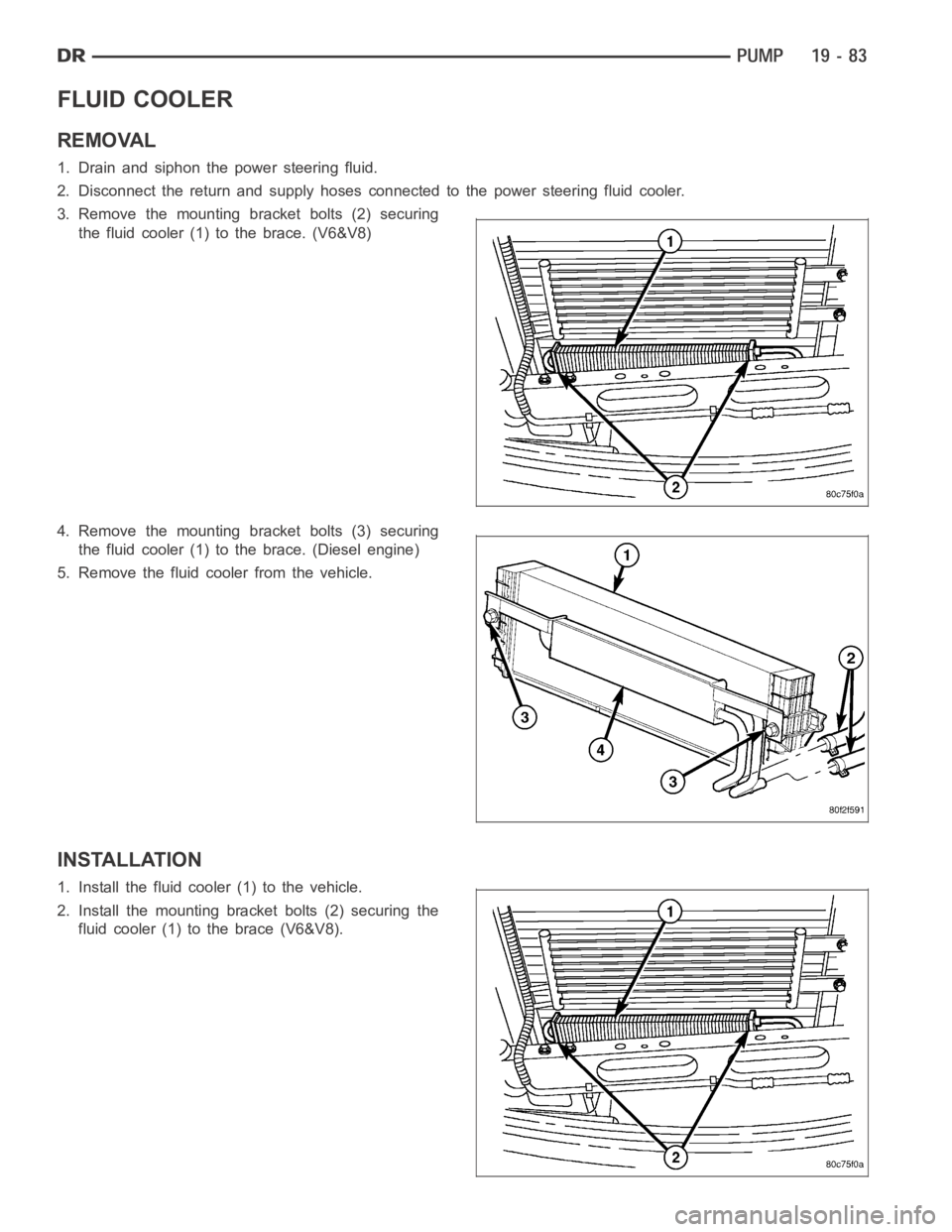
FLUID COOLER
REMOVAL
1. Drain and siphon the power steering fluid.
2. Disconnect the return and supply hoses connected to the power steering fluid cooler.
3. Remove the mounting bracket bolts (2) securing
the fluid cooler (1) to the brace. (V6&V8)
4. Remove the mounting bracket bolts (3) securing
the fluid cooler (1) to the brace. (Diesel engine)
5. Remove the fluid cooler from the vehicle.
INSTALLATION
1. Install the fluid cooler (1) to the vehicle.
2. Install the mounting bracket bolts (2) securing the
fluid cooler (1) to the brace (V6&V8).
Page 2489 of 5267

3. Install the mounting bracket bolts (3) securing the
fluid cooler (1) to the brace (Diesel Engine).
4. Reclamp the return and supply hoses to the power
steering fluid cooler (4).
5. Refill the power steering fluid (Refer to 19 -
STEERING/PUMP - STANDARD PROCEDURE).
Page 2494 of 5267
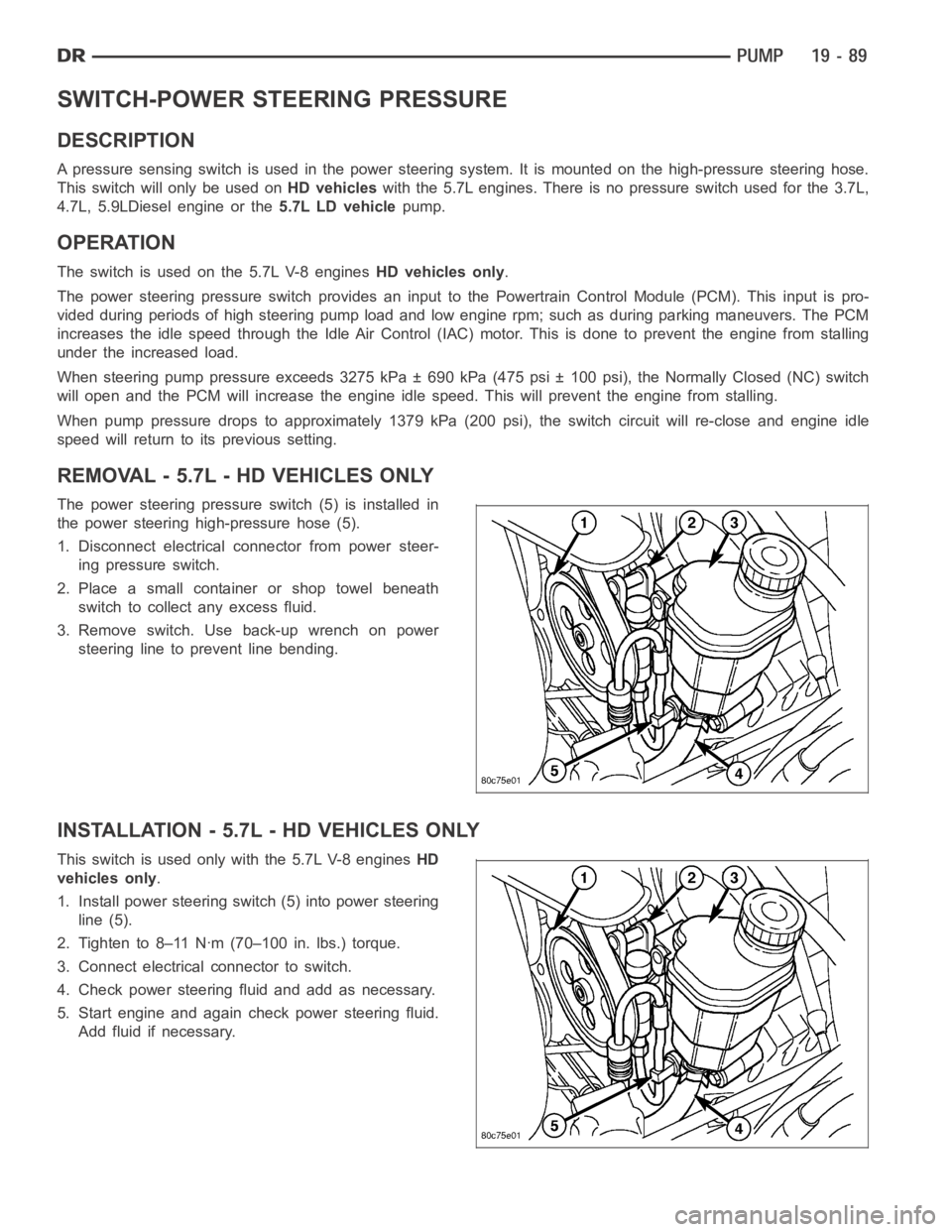
SWITCH-POWER STEERING PRESSURE
DESCRIPTION
A pressure sensing switch is used in the power steering system. It is mounted on the high-pressure steering hose.
This switch will only be used onHD vehicleswith the 5.7L engines. There is no pressure switch used for the 3.7L,
4.7L, 5.9LDiesel engine or the5.7L LD vehiclepump.
OPERATION
The switch is used on the 5.7L V-8 enginesHD vehicles only.
The power steering pressure switch provides an input to the Powertrain Control Module (PCM). This input is pro-
vided during periods of high steering pump load and low engine rpm; such as during parking maneuvers. The PCM
increases the idle speed through the Idle Air Control (IAC) motor. This is done to prevent the engine from stalling
under the increased load.
When steering pump pressure exceeds 3275 kPa ± 690 kPa (475 psi ± 100 psi), the Normally Closed (NC) switch
will open and the PCM will increase the engine idle speed. This will preventthe engine from stalling.
When pump pressure drops to approximately 1379 kPa (200 psi), the switch circuit will re-close and engine idle
speed will return to its previous setting.
REMOVAL - 5.7L - HD VEHICLES ONLY
The power steering pressureswitch (5) is installed in
the power steering high-pressure hose (5).
1. Disconnect electrical connector from power steer-
ing pressure switch.
2. Place a small container or shop towel beneath
switch to collect any excess fluid.
3. Remove switch. Use back-up wrench on power
steering line to prevent line bending.
INSTALLATION - 5.7L - HD VEHICLES ONLY
This switch is used only with the 5.7L V-8 enginesHD
vehicles only.
1. Install power steering switch (5) into power steering
line (5).
2. Tighten to 8–11 Nꞏm (70–100 in. lbs.) torque.
3. Connect electrical connector to switch.
4. Check power steering fluid and add as necessary.
5. Start engine and again check power steering fluid.
Add fluid if necessary.
Page 2495 of 5267
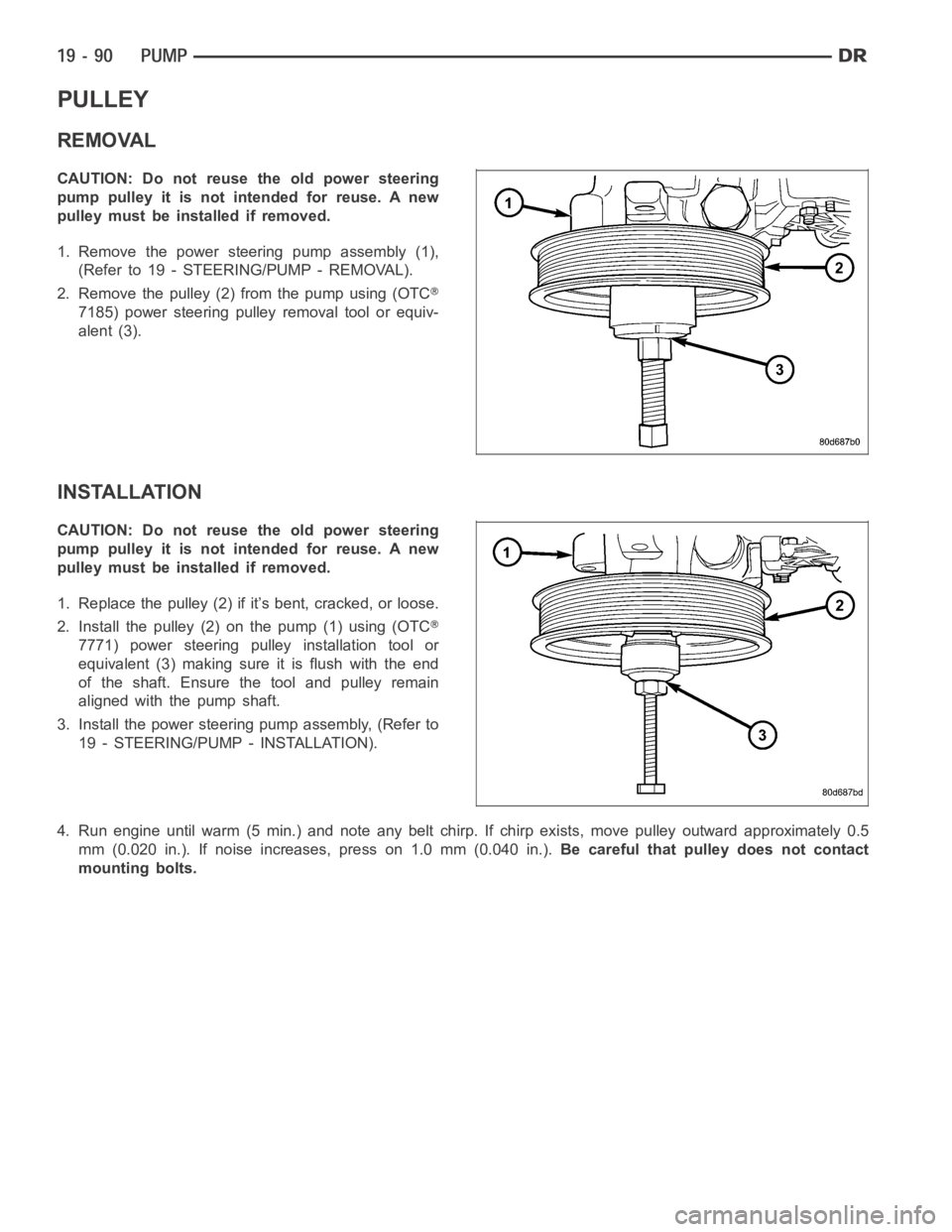
PULLEY
REMOVAL
CAUTION: Do not reuse the old power steering
pump pulley it is not intended for reuse. A new
pulley must be installed if removed.
1. Remove the power steering pump assembly (1),
(Refer to 19 - STEERING/PUMP - REMOVAL).
2. Remove the pulley (2) from the pump using (OTC
7185) power steering pulley removal tool or equiv-
alent (3).
INSTALLATION
CAUTION: Do not reuse the old power steering
pump pulley it is not intended for reuse. A new
pulley must be installed if removed.
1. Replace the pulley (2) if it’s bent, cracked, or loose.
2. Install the pulley (2) on the pump (1) using (OTC
7771) power steering pulley installation tool or
equivalent (3) making sure it is flush with the end
of the shaft. Ensure the tool and pulley remain
aligned with the pump shaft.
3. Install the power steering pump assembly, (Refer to
19 - STEERING/PUMP - INSTALLATION).
4. Run engine until warm (5 min.) and note any belt chirp. If chirp exists, move pulley outward approximately 0.5
mm (0.020 in.). If noise increases, press on 1.0 mm (0.040 in.).Be careful that pulley does not contact
mounting bolts.
Page 2498 of 5267
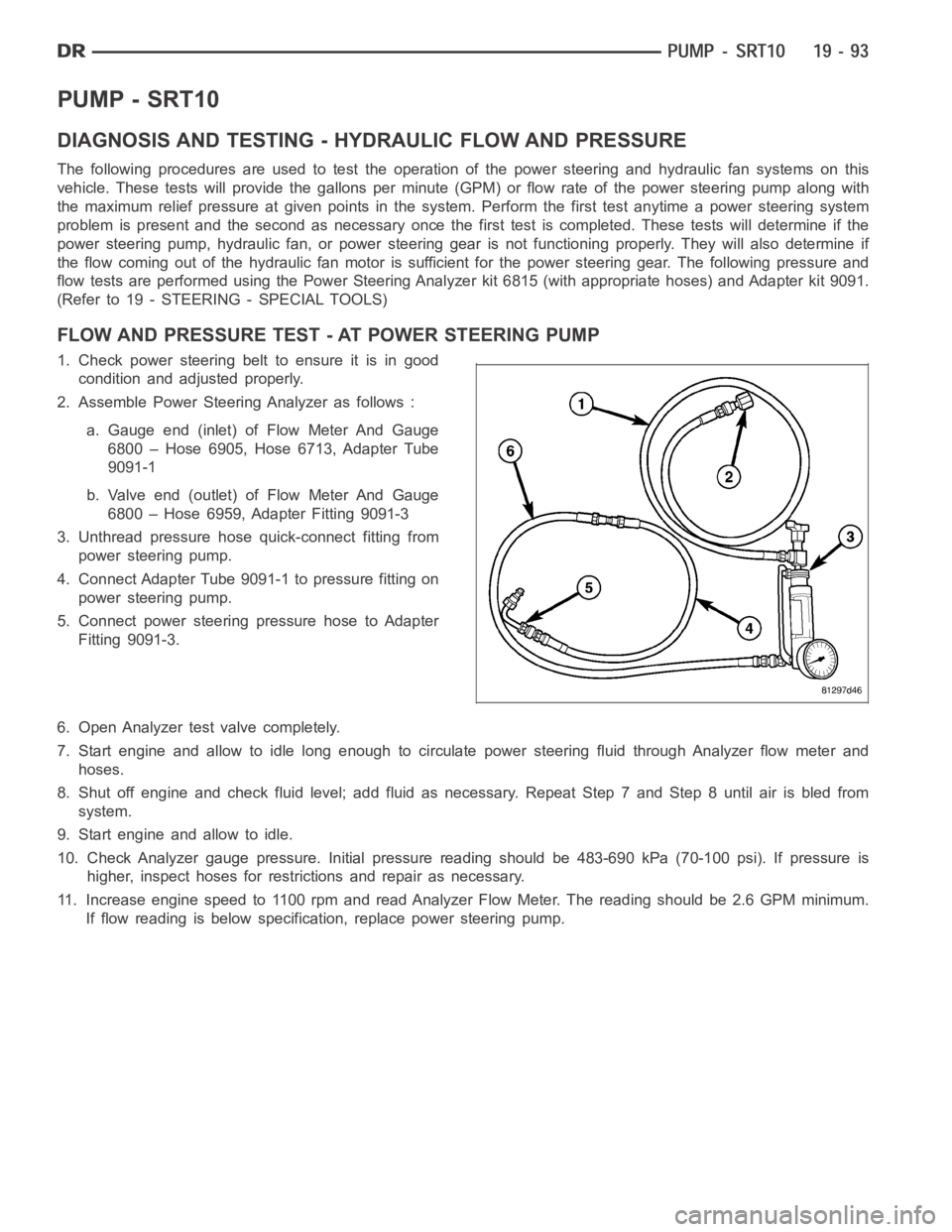
PUMP - SRT10
DIAGNOSIS AND TESTING - HYDRAULIC FLOW AND PRESSURE
The following procedures are used to test the operation of the power steering and hydraulic fan systems on this
vehicle. These tests will provide the gallons per minute (GPM) or flow rateof the power steering pump along with
the maximum relief pressure at given points in the system. Perform the first test anytime a power steering system
problem is present and the second as necessary once the first test is completed. These tests will determine if the
power steering pump, hydraulic fan, or power steering gear is not functioning properly. They will also determine if
the flow coming out of the hydraulic fan motor is sufficient for the power steering gear. The following pressure and
flow tests are performed using the Power Steering Analyzer kit 6815 (with appropriate hoses) and Adapter kit 9091.
(Refer to 19 - STEERING - SPECIAL TOOLS)
FLOW AND PRESSURE TEST - AT POWER STEERING PUMP
1. Check power steering belt to ensure it is in good
condition and adjusted properly.
2. Assemble Power Steering Analyzer as follows :
a. Gauge end (inlet) of Flow Meter And Gauge
6800 – Hose 6905, Hose 6713, Adapter Tube
9091-1
b. Valve end (outlet) of Flow Meter And Gauge
6800 – Hose 6959, Adapter Fitting 9091-3
3. Unthread pressure hose quick-connect fitting from
power steering pump.
4. Connect Adapter Tube 9091-1 to pressure fitting on
power steering pump.
5. Connect power steering pressure hose to Adapter
Fitting 9091-3.
6. Open Analyzer test valve completely.
7. Start engine and allow to idle long enough to circulate power steering fluid through Analyzer flow meter and
hoses.
8. Shut off engine and check fluid level; add fluid as necessary. Repeat Step7andStep8untilairisbledfrom
system.
9. Start engine and allow to idle.
10. Check Analyzer gauge pressure. Initial pressure reading should be 483-690 kPa (70-100 psi). If pressure is
higher, inspect hoses for restrictions and repair as necessary.
11. Increase engine speed to 1100 rpm and read Analyzer Flow Meter. The reading should be 2.6 GPM minimum.
If flow reading is below specification, replace power steering pump.
Page 2499 of 5267
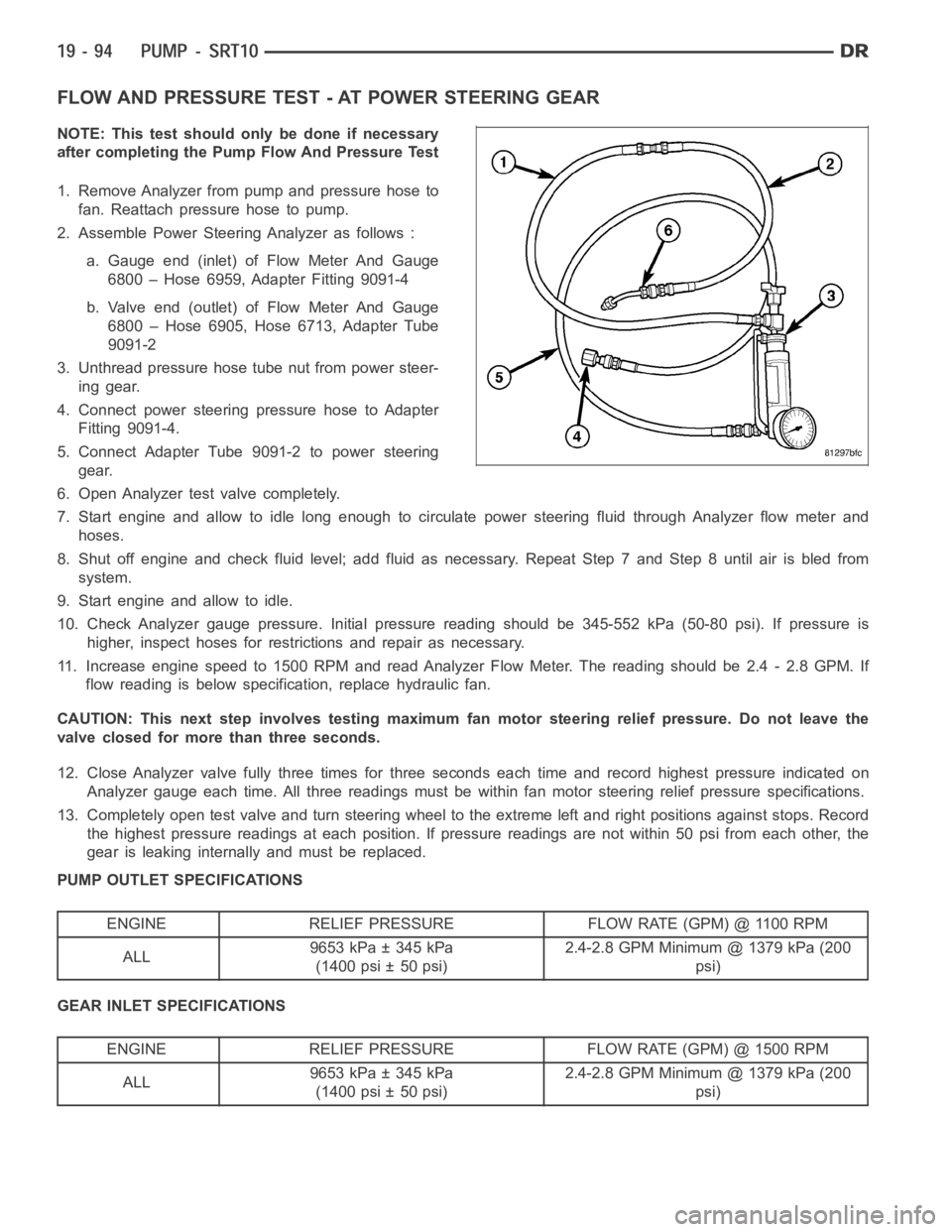
FLOW AND PRESSURE TEST - AT POWER STEERING GEAR
NOTE: This test should only be done if necessary
after completing the Pump Flow And Pressure Test
1. Remove Analyzer from pump and pressure hose to
fan. Reattach pressure hose to pump.
2. Assemble Power Steering Analyzer as follows :
a. Gauge end (inlet) of Flow Meter And Gauge
6800 – Hose 6959, Adapter Fitting 9091-4
b. Valve end (outlet) of Flow Meter And Gauge
6800 – Hose 6905, Hose 6713, Adapter Tube
9091-2
3. Unthread pressure hose tube nut from power steer-
ing gear.
4. Connect power steering pressure hose to Adapter
Fitting 9091-4.
5. Connect Adapter Tube 9091-2 to power steering
gear.
6. Open Analyzer test valve completely.
7. Start engine and allow to idle long enough to circulate power steering fluid through Analyzer flow meter and
hoses.
8. Shut off engine and check fluid level; add fluid as necessary. Repeat Step7andStep8untilairisbledfrom
system.
9. Start engine and allow to idle.
10. Check Analyzer gauge pressure. Initial pressure reading should be 345-552 kPa (50-80 psi). If pressure is
higher, inspect hoses for restrictions and repair as necessary.
11. Increase engine speed to 1500 RPM and read Analyzer Flow Meter. The reading should be 2.4 - 2.8 GPM. If
flow reading is below specification, replace hydraulic fan.
CAUTION: This next step involves testing maximum fan motor steering relief pressure. Do not leave the
valve closed for more than three seconds.
12. Close Analyzer valve fully three times for three seconds each time and record highest pressure indicated on
Analyzer gauge each time. All three readings must be within fan motor steering relief pressure specifications.
13. Completely open test valve and turn steering wheel to the extreme left and right positions against stops. Record
the highest pressure readings at each position. If pressure readings are not within 50 psi from each other, the
gear is leaking internally and must be replaced.
PUMP OUTLET SPECIFICATIONS
ENGINE RELIEF PRESSURE FLOW RATE (GPM) @ 1100 RPM
ALL9653 kPa ± 345 kPa
(1400 psi ± 50 psi)2.4-2.8 GPM Minimum @ 1379 kPa (200
psi)
GEAR INLET SPECIFICATIONS
ENGINE RELIEF PRESSURE FLOW RATE (GPM) @ 1500 RPM
ALL9653 kPa ± 345 kPa
(1400 psi ± 50 psi)2.4-2.8 GPM Minimum @ 1379 kPa (200
psi)
Page 2500 of 5267
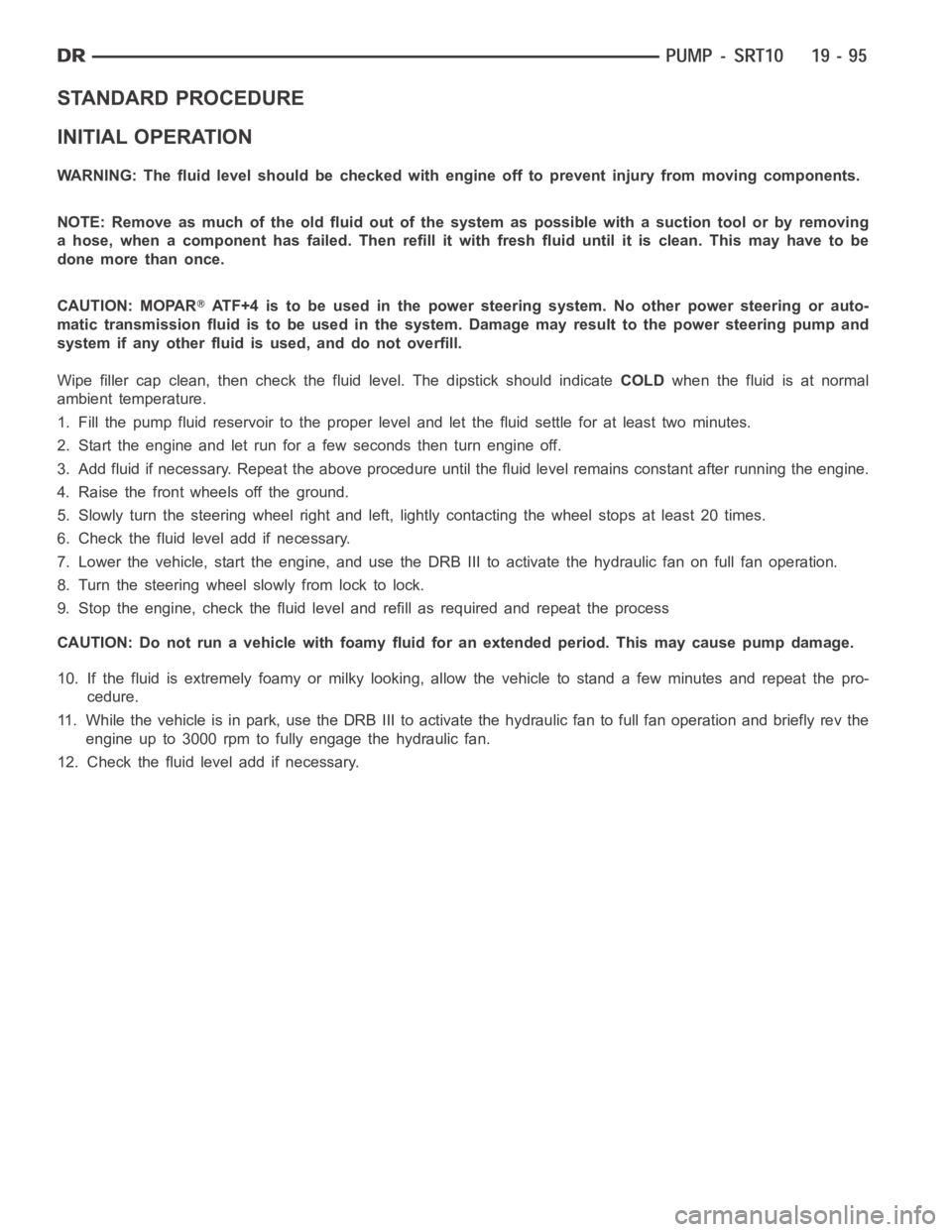
STANDARD PROCEDURE
INITIAL OPERATION
WARNING: The fluid level should be checked with engine off to prevent injury from moving components.
NOTE: Remove as much of the old fluid out of the system as possible with a suction tool or by removing
a hose, when a component has failed. Then refill it with fresh fluid until itis clean. This may have to be
done more than once.
CAUTION: MOPAR
ATF+4 is to be used in the power steering system. No other power steering or auto-
matic transmission fluid is to be used in the system. Damage may result to the power steering pump and
system if any other fluid is used, and do not overfill.
Wipe filler cap clean, then check the fluid level. The dipstick should indicateCOLDwhen the fluid is at normal
ambient temperature.
1. Fill the pump fluid reservoir to the proper level and let the fluid settlefor at least two minutes.
2. Start the engine and let run for a few seconds then turn engine off.
3. Add fluid if necessary. Repeat the above procedure until the fluid levelremains constant after running the engine.
4. Raise the front wheels off the ground.
5. Slowly turn the steering wheel right and left, lightly contacting the wheel stops at least 20 times.
6. Check the fluid level add if necessary.
7. Lower the vehicle, start the engine, and use the DRB III to activate the hydraulic fan on full fan operation.
8. Turn the steering wheel slowly from lock to lock.
9. Stop the engine, check the fluid level and refill as required and repeat the process
CAUTION: Do not run a vehicle with foamy fluid for an extended period. This may cause pump damage.
10. If the fluid is extremely foamy or milky looking, allow the vehicle to stand a few minutes and repeat the pro-
cedure.
11. While the vehicle is in park, use the DRB III to activate the hydraulic fan to full fan operation and briefly rev the
engine up to 3000 rpm to fully engage the hydraulic fan.
12. Check the fluid level add if necessary.